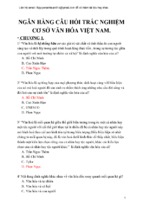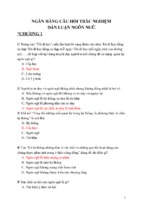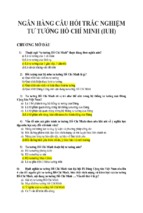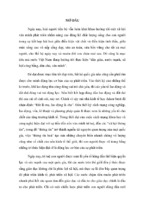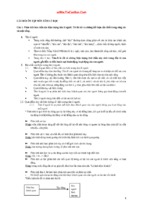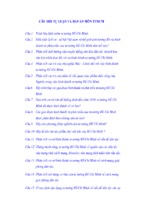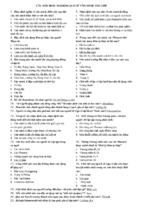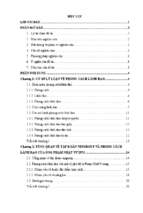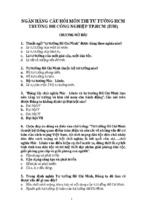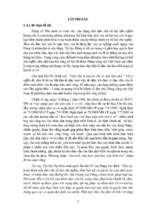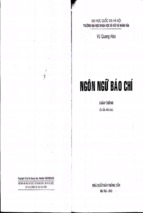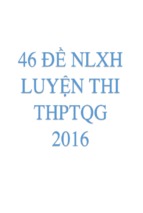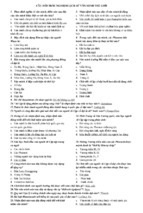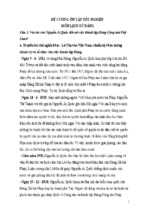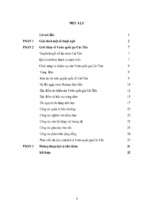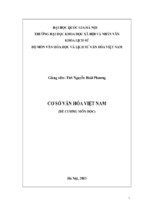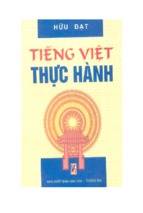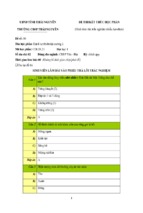MINISTRY OF EDUCATION AND TRAINING
UNIVERSITY OF TRANSPORT AND COMMUNICATIONS
TRAN THI CAM HA
RESEARCH ON COMPONENTS, MECHANICAL
PROPERTIES AND THE APPLICABILITY OF EPOXYBITUMEN BINDER FOR ASPHALT MIXTURES IN
VIETNAM
Field of study: Transport engineering
Code : 9580205
Speciality: Highway and urban road engineering
SUMMARY OF DOCTORAL THESIS
HANOI – 2020
This research is completed at:
University of transport and communications
Supervisors:
1. AssocProf.Dr. Tran Thi Kim Dang
University of Transport and Communications
2. Prof.Dr. Bui Xuan Cay
University of Transport and Communications
Reviewer 1: Prof.Dr Nguyen Xuan Truc
Reviewer 2: Prof.Dr Nguyen Thuc Tuyen
Reviewer 3: Prof.Dr Pham Cao Thang
The thesis will be defended before Doctoral-Level Evaluation
Council at University of Transport and Communications
at ……. on …….th …….. 2020
The thesis can be read at:
1. National Library of Vietnam
2. Library of University of Transport and Communications
AUTHOR’S PUBLICATION LIST
1. Tran Thi Cam Ha, Tran Thi Kim Dang (2017), “A study on several
mechanical properties of epoxy bitumen”, Transport Journal No 5/2017.
2. Tran Thi Cam Ha, Bui Xuan Cay (2018), “Experimental research on static
elastic modulus and flexural strength of epoxy asphalt concrete”, Transport
Journal No 5/2018.
3. Tran Thi Cam Ha (2018), “Experimental research ondynamic shear
modulus of bitumen- epoxy”, Transport Journal No 11/2018.
4. Tran Thi Cam Ha, Nguyen Quang Tuan, Tran Anh Tuan, Hoang Viet Hai
(2018), “Shear behavior of epoxy asphalt concrete coating and epoxy
adhesive on steel deck”, Transport and Communication Science Journal No
66.
1
INTRODUCTION
I. Research background
In fact, the use of asphalt pavements on main national road in Vietnam showed
that there was a lot of premature deterioration of asphalt pavements such as
rutting in National road No.5, National road No.1, East – West boulevard, the
access road to Thanh Tri bridge, Ring road No.3; the deterioration of the
overlay on Thanglong bridge; deep rutting on the road linked to Cat Lai port...
This deterioration greatly affected the socio-economic development, so the
government had to spend a lot of money to repair these deterioration.
Moreover, this also affects the physical and mental well -being of road users.
In many countries in the world such as UK, USA, Japan, Ukraine..., the
research and the use of modified asphalt mixtures with epoxy-bitumen binder
as the surface layer for heavy roads and steel bridges have achieved good
results. These modified asphalt surface significantly reduced the deterioration
compared with asphalt pavements using conventional bituminous binders.
Vietnam has also had a project using epoxy asphalt concrete (BTNE) as the
surface of Thuan Phuoc bridge – Danang city. Unfortunately this first
application was not successful. This epoxy asphalt concrete surface on Thuan
Phuoc bridge has therefore been replaced almost entirely by the modified
asphalt mixture (BTNP) using polymer modified bitumen. The researches
about this material before applying for Thuan Phuoc bridge were also quite
limited.
Currently, in Vietnam, epoxy can be supplied by domestic and foreign
suppliers, but there has not been any study about the applicability of epoxy bitumen binder for modified asphalt mixtures.
Therefore, the thesis "Research on components, mechenical properties and the
applicability of epoxy-bitumen binder for asphalt mixtures in Vietnam” is
scientific and practical.
II. Research objective
For the purpose of researching on the applicability of BTNE in the field of
transport Works, the thesis focuses on the component, mechanical properties,
technical standards and the workability of BTNE.
III. Reseach contents
The thesis contents include:
1. Overview study of BE and BTNE;
2. Empirical research to determine the properties of BE materials, evaluate
the applicability of BE binders for BTNE mixtures using in road pavement
structures; analysis and selection of epoxy content for BE binder for BTNE
mixtures;
2
3. Empirical research in the laboratory to determine the physical and
mechanical properties of BTNE as a basis for assessing the applicability
and scope of use of BTNE materials;
4. Proposing some typical pavement structures using BTNE material as
surface layers.
IV. Scientific and practical contribution
Scientific contribution: The thesis studies mechanical properties of BE
binder and BTNE mixture, analyzes the advantages and disadvantages and
the scope of application of this new material in Vietnam conditions.
Systematizing testing standards for quality assessment of BE binder and
BTNE mixture.
Practical contribution: Based on experimental research results of BTNE
mixture compared with other types of asphalt mixtures, thereby proposing
the method of designing mixed components, proposing experiment al
standards for quality assessment of BTNE mixture; From mechanical
properties of BTNE, the thesis proposes some road pavement structures
using BTNE surface course in Vietnam.
CHAPTER 1
LITERATURE REVIEW
Chapter 1 provides an overview of the use of BE and BTNE as the basis for the
selection of epoxy for empirical studies in the following chapters.
1.1. Epoxy bitumen and epoxy asphalt mixture
1.1.1. Overview of additives to improve the performance of bitumen
Main components of modified
bitumen
are
bitumen
and
additives. The additives using for
bitumen includes 3 basic groups:
non-polymer, polymer and the
chemical
additive
(create
chemical
reactions
when
blending). The types of polymer
additives is shown in Table 1-1.
1.1.2. Epoxy resin
Epoxy resins are a class of
thermoset materials – transformed into solid form under the action of heat or a
chemical reaction that is then not melted or dissolved again. Epoxy offer high
strength, low shrinkage, excellent adhesion to various substrates, chemical and
solvent resistance and low toxicity. Epoxy resins are used as glues, coatings,
packaging, molding materials and adhesives, etc.
3
An epoxy resin are made by mixing three basic components: basic resin (main
resin), curatives, and the modifiers. For a simple mixing formula, an epoxy
resin only includes a single epoxy resin and curative. Other formulas can
include various epoxy resins, modifiers and a combination of curatives.
1.1.2.1. Basic resin (main resin)
The term “epoxy resin” describes a broad class of
thermosetting polymers in which the primary cross
linking occurs through the reaction of an epoxy
group. In general, an epoxy resin can be thought of
as a molecule containing a three-membered ring,
Fig. 1-1. Basic chemical
consisting of one oxygen atom and two carbon structure of epoxy group
atoms (Fig. 1-1).
Two branches connected to two carbon atoms of the ring can be very diverse,
thereby creating different types of epoxy resins.
1.1.2.2. Epoxy Resin Curatives
Epoxy resins will react with a large number of chemical species called
curatives or hardeners. The most commonly used chemical classes of curatives
are amines, amine derivatives, and anhydrides. Cure times can range from
seconds to days, even months to years at room temperature. The materials have
been separated into the general categories of room temperature cure, room - or
elevated-temperature cure, elevated temperature cure, and miscellaneous
curatives.
1.1.3. Epoxy bitumen
Epoxy bitumen (BE) is a two-component (two-phase) chemical system in
which a part is thermoset epoxy (continuous phase) mixed with ordinary
bitumen (dispersed phase). Bitumen is a heat sensitive adhesive, which
becomes flexible when heated and hardens when cooled. Epox y is a thermoset
material that becomes permanently hard after curing. Epoxy bitumen is a
thermosetting material that has both the rigidity of epoxy and the flexibility of
bitumen. The percentage of epoxy in BE usually ranges from 15% to 50% by
weight.
1.2. Studies of epoxy-bitumen (BE) and epoxy asphalt mixture in the world
A lot of studies about BE and BTNE have been done around the world. For
example, the BE pilot project with the participation of 7 countries including
Denmark, France, Germany, New Zealand, Ukraine, United Kingdom and USA
was implemented from 2006 to 2008; the research project of BTNR using local
materials in China in 2002; Studies about BE and BTNE in Japan in the late
70s of the 20th century. These studies have shown that BTNE material has
high fatigue resistance (10 times higher than conventional asphalt concrete
BTN), high rutting resistance (almost no rutting in wheel track tests), good
tensile strength and good anti-skid resistance.
4
1.3. Some applications of BTNE all over the world
BTNE mixture can be used as an overlay on the bridge deck, surface layer of
long life pavements, airport runway pavements, roads on port area, asphalt
surface layer for inproving pavement texture.
1.4. Some researches and applications in Vietnam
Until now, Vietnam also has the project “Thuan Phuoc Bridge - Da Nang city”
which used BE and BTNE. The overlay on the steel plate deck is a 41mm thick
BTNE layer. The water-proof layer use a type of BE binder which is also an
adhesive layer between the steel plate surface and the above BTNE layer. BE
used in the project is Epoxy Asphalt Id of Chemco System (USA).
Thuan Phuoc Bridge was opened to traffic on July 14, 2009. By the hot season
of 2013, the asphalt overlay on the bridge deck was seriously damaged on a
large scale. It greatly affected traffic on the bridge. The observation results
during the 4 years showed that the worst status of the asphalt surface layer
occured after each hot period in June and July every year, so it can be
confirmed that high temperature was a main factor causing damage to the
overlay. The asphalt layer on Thuan Phuoc steel deck surface suffered from
disadvantages relating to working temperature due to heat accumulation effect
in the 655m long closed steel
box beam without ventilation
system.
In
summer,
temperature inside the steel
box beam can be up to 7080 0 C. This makes the overlay
and the adhesive layer always
worked at a disadvantage.
Fig. 1-21.
Damages
on Thuan
Phuoc
. Các hư
hỏng do hiện
tượng xô
dồn bề mặt,
In 2013, Thuan Phuoc bridge
bridge
surface
after
was conducted to repair the
mất sự liên
kết với
bản thép
sau 44 years
năm khai thác
overlay: Digging away the old
BTNE layer. After that a new overlay included 2 asphalt layers of BTNP
PMB3. The thickness of total 2 layers is 800 mm. Adhesive layer between
BTNP layer and steel plate with two-component epoxy resin of Chemco
System (USA) was still used. Adhesion strength was enhanced by welding
steel ribs 80cm apart on steel deck. Between 2 layers of BTNP was reinforced
by fiberglass mesh layer with tensile strength of 100 kN.
After repaired, the overlay was still damaged after 5 years of the operation and
is being continued to be repaired.
1.5. Problem statement
The thesis focuses on solving the following issues:
- Researching on componets of epoxy-bitumen and modified asphalt mixtures
using epoxy-bitumen in order to suit with climatic conditions and construction
technology level in Vietnam;
5
- Initially proposing technical properties of epoxy-bitumen (with particular
components) and BTNE mixture using BE binder for road pavement’s surface layers
in Vietnam condition;
- Proposing and evaluating some pavement structures using BTNE surface layer;
Recommending suitable pavement structures for highway and bridge deck;
- Making some initial recommendations on production technology and
construction technology of BTNE in Vietnam.
The thesis carefully studies about components, mechanical properties, technical
standards, applicability of BTNE without researching on construction technology of it
in field.
1.6. Research methodology
Combining between of research methods: theoretical method, experimental
method, statistical probability method, experimental method and modeling
method.
CHAPTER 2
RESEARCH ON COMPONENTS AND BASIC PROPERTIES OF
EPOXY- BITUM
Chapter 2 carries out empirical research in laboratories for purpose of
selecting the type of epoxy, the rate and the method of mixing bitumen and
epoxy; Experiments were conducted to determine technical characteristics of
BE binder compared with some bitumens used commonly in Vietnam.
2.1. Determining components and method of manufacturing BE binder
2.1.1. Selection of epoxy resin
Epoxy resin used in this research is
provided by TAIYU KENSETSU,
JAPAN. This type of epoxy is
widely used in Japan, China and
even in Korea. Epoxy resin
includes two main components:
basic
resin
and
curatives
(hardener).
The
technical
characteristics of each component
and mixing ratios shown in Table
2-3.
2.1.2. Selecting type of bitumen
used in research
Bitumen 60/70 of Shell, Singapore was used to manufacture BE binder.
6
2.1.2.1. Content of epoxy in epoxy - bitumen
The technical properties of BE binder vary with different contents of epoxy in
binders. In this study, the properties of BE binders were be tested with epoxy
contents of 15%, 20%, 30%, 35%, 40%, 50% by weight. They were
abbreviated respectively: BE15, BE20, BE30, BE35, BE40, BE50.
2.1.2.1. Steps of mixing epoxy-bitumen
-
Step 1: Producing epoxy resin: Blending main resin with curatives in proportion
of 56:44 during one minute in order to produce epoxy resin for the research.
Step 2: Producing BE binder: Mixing bitumen 60/70 with epoxy resin made
from step 1 in a paricular proportion during 4 minutes. BE binder obtained from
this process will be poured into a mold and dried at 150 0 C for 1 hour.
Step 3: Maintaining BE sample (As shown in section 2.1.4)
2.1.3. Setting out a time interval and temperature level of epoxy-bitumen
sample curing before testing
In this study, BE binder was cured at two different temperature levels: 60 0 C
(corresponding to the temperature of pavement surfaces in very hot summer
areas and on steel plate bridges); 25 0 C (corresponding to average temperature
in Vietnam). For the cured samples at room temperature of 25 0 C, tests for them
were carried out at different curing time intervals: 2h, 4h, 24h, 48h, 72h, 96h
and 168h., tests for them was conducted after curing during 96h for cured
sample at 60 0 C.
2.2. Selecting technical specifications and testing methods for BE binders
In Vietnam, TCVN 7493: 2005 "Bitumen-technical requirements" are used to
assess the quality of bitumens. All 7 technical characteristics to evaluate
bitumens according to this specification were applied to BE binders. In
addition, viscosity and dynamic shear modulus (DSR) of BE binders were al so
performed in this study. Testing methods comply with current standards.
Using Minitab software to design general experiments. The number of common
repetitions is 3. ANOVA analysis and post-editing analysis used to detect
differences according to Tuckey standard. Carrying out the evaluation to
remove outliers according to ASTM E178; evaluating the precision according
to ASTM C670 with the acceptable limits specified by the respective standard
tests.
2.3. Penetration of BE binder with diffirent percentages of epoxy
Penetration tested in accordance with TCVN 7495: 2005. The total number of
experimental sample groups was 49.
By precision analysis in accordance with ASTM D5 -2013, it could be
confirmed that penetration test results me t the precision requirements.
7
Fig. 2-1. Relationship between
penetration and epoxy content and
different curing conditions
Fig. 2-2. Penetration values of epoxy bitumen
- Penetration (Pe) decreases with increasing epoxy content. In the case of
epoxy content less than 30%, the reduction rate of Pe is about 6,5 ÷ 15
(1/10mm) corresponding to increasing by 15% epox. The average decrease is
3,64 (1/10mm)/5% increase of epoxy content). The rate of reduction in Pe is
significant (average reduction of 6.7 (1/10mm)/5%) if the epoxy content
increases from 30% to 35%. In the case of epoxy content greater than 35%, the
rate of reduction returned to the original level with an average of 3,64
(1/10mm)/5% [see fig. 2-5 and fig. 2-6].
- PE of BE binders in all types of content decreases with increasing curing
time, but for the epoxy content below 35% this reduction is negligible and
almost stable at 96h; At 35%, 40% and 50%, this reduction is obvious with
increasing curing time (see fig. 2-6).
- PE of samples cured at 60 0 C for 96h were lower than those of samples cured
at 25 0 C for 168h. For samples with 50% epoxy content and curing at 60 0 C for
96h, Pe was lower than 20 (1/10mm) (see fig. 2-5).
The reduction of PE or the increased hardness of the BE binder compared with
conventional bitumen is due to epoxy resin as a thermoset component. In BE
binders, epoxy is a three-dimensional continuous phase that is hard and
becomes harder when heated. As epoxy content increases, the mixtures with
more hard components reduce their Pe, while BE binder cured at higher
temperature makes it harden faster. Long curing time makes BE continue to
complete dispersion phase of epoxy and increase the hardness of BE binder.
Setting up the second regression equation showing the relationship between Pe
and variables (BE and T) in research limit as follows :
Pe = 79,62 – 1,0153 BE – 0,06700 T + 0,00990 BE*BE + 0,000283 T*T – 0,003223 BE*T
The equation ensures reliability with the adjustment coefficient R
p-value of all parameters is less than 0,05.
(2-1)
2
đc
= 97,68%,
2.4. Softening point (ring-and-ball apparatus)
This test was carried out according to TCVN 7497:2005 - ring-and-ball
apparatus . Total number of sample groups was 49.
8
Precision analysis of softening point test results according to ASTM D36 -2014
showed that their precision was satisfactory.
Fig. 2-9. Relationship between softening
point and epoxy content and different curing
conditions
Fig. 2-3. Softening point values of epoxy
bitumen
- SP ( Softening point ) increases with increasing epoxy content. SP increases
slowly (average of 1.3 0 C/5% increase in epoxy content) with an increase from
15% to 30%. An increase of SP is significant when the epoxy content is more
than 30%. In the range of epoxy content from 30% to 50%, SP increases from
10 ÷ 60 0 C, corresponding to an average of approximately 7 0 C for every 5%
increase in epoxy content. This is shown in the slope of the straight lines in the
graph of the relationship between SP and epoxy content which increases
significantly at 30% epoxy content (See Fig. 2-10 and Fig. 2-9).
- As sample curing time at room temperature increased, SP of all epoxy bitumen with different epoxy contents increased. However, when the epoxy
content was below 35%, the increase was negligible and almost no longer
increased after 96 hours. With epoxy contents of 35%, 40% and 50%, the
increase is noticeable as sample curing time increases. Of the three types of
BE (with expoy contents as above), the growth rate of 50% epoxy sample is
the largest, 35% epoxy sample is the smallest (see Fig. 2-10).
- SP of curing samples at 60°C for 96 hours is higher than that of curing
samples at 25 0 C for 168 hours. With 50% epoxy content and curing at 60 0 C for
96h, BE does not soften even at 120 o C (see Fig. 2-9)
- Samples are cured at 25 0 C and 168h after mixing, SP of BE35 is equivalent
to PMB-II, of BE40 is equivalent to PMB-III and of BE50 is up to 117 0 C.
The theoretical basis for change of SP is similar to that for Pe. Thermoset
epoxy component included in BE binder increases temperature resistance,
maintains hardness of BE in high temperature. A higher epoxy content expands
thermosetting continuous phase which increases the stiffness of BE rapidly
under high temperature. As with Pe, curing samples at high temperatures
rapidly increases the hardness of BE. Long service time has the effect of
developing a dispersed thermoset phase, thereby increasing SP of BE binder.
The longer curing time is, the more dispersed thermoset phase develops,
thereby increasing SP of BE binder.
9
Setting up the second regression equation showing the correlation between SP
and BE and T variables within the study limits as follows :
SP = 70,33 – 1,319 BE – 0,1590 T + 0,02371 BE*BE + 0,008356 BE*T
(2-2)
The correlation equation ensures the reliability with the adjusted determination
R 2 đc = 94,61% and the p-value of the parameters are less than 0,05.
2.5. Proposal for selection of BE components
From the test results for penetration and softening point of BE binders, the
following conclusions are drawn:
- Epoxy content ≤ 30%: The rate of reduction of Pe and increase of SP is not
significant; PE of BE binders with all tested curing conditions ranges from
40-65 (1/10mm), only equivalent to PMB -II and PMB-III; when expoy
content is lower than 30%, SP of BE binders in all curing conditions is
lower than 60 0 C which is lower than PMB-I; With an epoxy content of
30%, if cured at room temperature (25 0 C), SP only reaches 60,25 0 C with
curing samples for 168h and if cured at 60 0 C for 96h, SP reaches 61,55 0 C,
which is equivalent to PMB I.
- With epoxy content of 35% or more, Pe and SP of BE are superior to those
of bitumen 60/70. With 50% epoxy content, these two properties are still
superior to those of PMB-III. Details are as follows:
+ With BE35: if curing samples at 25 0 C for 168h or curing at 60 0 C for 96h,
SP of them is equivalent to PMB-II (higher than 70 0 C);
+ With BE4: if cured at 25 0 C from 72h to 96h, SP is equivalent to that of
PMB-II (higher than 70 0 C); if curing samples for 168h or curing at 60 0 C
for 96h, SP is equivalent to that of PMB -III (higher than 80 0 C);
+ With BE50: if cured at 25 0 C for 96h, its SP is equivalent to PMB III;
Especially, if curing time reaches 168h or curing at 60 0 C for 96h, its SP
can be up to 120 0 C - superior to PMB-III.
+ Pe is lower than that of PMB-III (below 40 1/10mm) when cured above
96h at 25 0 C with BE35 and BE40, over 72h at 25 0 C with BE50.
From the above conclusions, choosing 02 types of BE binders (BE35 and
BE50) corresponding to 35% and 50% epoxy by total weight of BE mixing to
conduct further studies in the thesis.
2.6. Experiment on basic properties of
BE binder
Experimental results of other basic
properties of BE35 and BE50
according to TCVN 7493:2005 in
table 2-13 show that properties of
both tested BE35 and BE50 meet the
requirements for 60/70 bitumen.
10
2.7. Dynamic shear modulus of BE binder
- DSR test results of original BE15, BE35 and BE50 binders are equivalent to
PG70, PG76 and PG82.
- PG of BE35 and of BE50 after RTFO remain the same as the original BE
resin, respectively PG76 and PG82.
- PG of BE15 after the RTFO decreases by one level compared to PG of
corresponding original BE, from PG70 to PG64, which is equivalent to PG of
ordinary bitumen 60/70 (BE0).
2.8. Conclusion for chapter 2
BE binders using epoxy supplied by TAIYU, Japan meet the requirements
for bitumen used in construction according to TCVN 7493:2005. With an
epoxy content of 35% or more, SP of BE binder is significantly higher
than that of conventional bitumen. With epoxy content up to 50%, this
property is also superior to that of PMB III. It is recommended to use BE
type with a minimum epoxy content of 35% by weight of BE.
SP and Pe of BE binders are affected by curing time and temperature. The
higher the epoxy content is, the greater the influence of these factors on SP
and Pe.
At an air temperature of 25 0 C, after mixing for 4 hours, there is any
significant difference between properties of BE binder and of bitumen
60/70, so the use of BE as a binder for asphalt mixtures will not meet
difficulties in the process of blending in asphalt mixing plant and in
construction.
The decline of Pe to approximately 20-25 (1/10mm) during the use of
pavements is a risk for cracking by hardening of bitumen. Therefore, it is
necessary to study the effect of increasing hardness of bitumen on crack
resistance by fatigue testing for asphalt concrete using BE binder.
PG of BE15, BE35 and BE50 are based on |G*|/sin of original BE and
after RTFO are PG64, PG76 and PG82 respectively.
CHAPTER 3
EXPERIMENTAL RESEARCH ON MECHANICAL AND PHYSICAL
PROPERTIES OF BTNE USING BE BINDER
Chapter 3 focuses on the study of technical properties of BTNE to assess the
quality of them, analyze pavement structure s with BTNE surface layers in
Vietnam. In addition to common mechanical properties (Marshall stability and
flow, static elastic modulus,...), other properties (fatigue life, dynamic
modulus...) of BTNE were also analyzed and evaluated.
3.1. Mix design of BTNE mixtures and reference mixtures
11
From the conclusions of
Chapter 2, this chapter only
conducted
experiments
in
BTNE
(BTNE35
and
BTNE50) respectively using
BE35 binder and BE50 binder.
The reference mixture is
BTNP using PMB III binder.
The study only focused on
only one aggregate gradation with a nominal maximum size of 12,5mm
(BTNC12,5) with all 3 types of binders: BE35, BE50 and PMB. III (see Fig. 3 1).
Optimum asphalt content range
is determined by Marshall
method
(see
Table
3-6).
Choosing
optimal
asphalt
content value corresponding to
Va equal to 4,5% ÷ 5,0% (recommended range arcording to Decision 858/QĐ BGTVT). Selecting optimum asphalt content for BTNP mixture was 5,2% by
mixed weight, for both BTNE35 and BTNE50 mixtures were 6,0% by mixed
weight.
3.2. Preparation of experimental samples of BTNE
Step 1: Mixing BE binder according to the steps in section Error!
Reference source not found.
Step 2: Mixing BTNE mixtures.
- After mixing, BE binder as mentioned in Step 1 will be immediately
put into the oven to dry at 140 0 C.
- Coarse and fine aggregates are dried at approximate 170 0 C, mineral
powders do not need drying.
- Mixing BE binder, coarse and fine aggregates and mineral powders
similar to conventional asphalt mixture.
Step 3: Preparing of experimental asphalt samples by gyration or roller
compactor. After that, BTNE samples was cured at 25 0 C for 168 hours (7
days) before tesing.
In summary, it can be seen that the process of preparing BTNE samples for
testing to determine properties of BTNE mixtures is similar to that of
conventional AC mixture, except for the production of BE binder.
3.3. Marshall stability, flow and residual stability
3.3.1. Result of Marshall test and analysis
An assessment of precision of Marshall stability and flow arcording to ASTM
D6927-15 showed that these results were satisfactory.
12
Marshall stability of BTNE50 when
immersed in water at 60 0 C for 1h is
51,72 kN, 3,328 times as much as that
of
BTNP
(15,56
kN)
and
approximately 1,53 times as much as
that of BTNE35 (33,86 kN). Marshall
stability of BTNE50 when immersed
in water at 60 0 C for 24 h is 46,33 kN,
3,319 times as much as that of BTNP
(13,96 kN) and approximately 1,59 times as much as that of BTNE35 (29,08
kN). Average value of Marshall stability of BTNE35 is 2,18 times and 2,08
times as much as these of BTNP when immersed in water at 60 0 C for 1h and
for 24h respectively.
From ANOVA analysis results of
Marshall flow, following conclusions can be drawn:
- Influence of sample immersion time on Marshall flow is statistically
significant;
- The type of BTN does not affect Marshall flow. It means Marshall flow of
BTNE is similar to that of BTNP. This is an advantage of BTNE, Marshall
stability is much higher than that of BTNP but Marshall flow is still in the
required range.
Marshall flow of the mixes ranges from
3mm - 6mm, meets the requirements of
BTNP mixture (see Fig. 3-5).
BE binder with epoxy - thermosetting
component has played an important role
in forming hardness and improve
Marshall stability of BTNE. Asphalt
component maintains plasticity of
BTNE mixtures which is shown by Marshall flow not much different from that
of BTNP.
3.4. Static elastic modulus of BTNE
Static elastic modulus tested for 3 different temperatures (15 0 C, 30 0 C and
60 0 C) complies with Annex C, 22TCN211-06.
13
3.4.1. Test result and analysis
At test temperatures of 15 0 C, 30 0 C, 60 0 C,
average static elastic modulus (E đh ) are
64,98%, 35,60% and 24,37% higher than
those of BTNP, respectively.
At 15 0 C, the difference of E đh between 3
types of BTN is significant, the degree of
difference between them decreases at
30 0 C, and is no longer significant at
60 0 C, especially between BTNE35 and BTNP.
3.4.2. Representative static elastic modulus of BTN
At 15 0 C, 30 0 C, 60 0 C, E đh đt is higher
than that of BTNP respectively by
61,56%, 32,43% and 20,04%; E đh đt
of BTNE35 is 30,81%, 9,90% and
4,35% higher than that of BTNP
(see Table 3-12).
The results of static elastic modulus test show that BTNE has higher
deformation resistance than conventional asphalt concrete (BTN) and also
higher than BTNP using PMB III which are commonly used in Vietnam. Epoxy
with the ability to improve hardness and maintain elasticity of BE is a factor
that enhances the deformation resistance of BTNE.
3.5. Flexural strength of BTNE
Flexural strength of asphalt concrete is
determined in accordance with annex C
of standard 22 TCN 211-06. The test was
performed on beam samples with
dimensions of 240x60x60 mm.
3.5.1. Result of flexural strength test
and analysis
At 15 0 C, R ku of BTNE35 and that of
BTNE50 respectively 1,07%, 87,44%
higher than that of BTNP. Experimental results are statistically significant at
the 95% confidence level. Analysis of fracture cross-section of the sample
after the test (see Fig. 3-16) showed that: fracture of BTNE35 and BTNP
samples only occurred at position of BE binder. Fractures of the BTNE50
samples were very flat and cut through aggregate particles. It shows that BE50
has very high hardness due to epoxy component in BE binder.
14
a. BTNE50
b. BTNE35
c. BTNP
Fig. 3-1. Photos of fractures after bending test
3.5.2. Representative flexural strength of BTN
At 15 0 C, R kuđt of BTNE35 and
BTNE50 are respectively 21,95%,
93,96% higher than that of BTNP.
R kuđt of BTNE50 is 59.05% higher
than that of BTNE35. Thus, it can
be seen that bending resistance of
BTNE50 is superior to that of BTNE35 and BTNP. High tensile flexural
strength at 15 0 C is quite consistent with the results of a pilot project in Europe.
These results indicate that the role of main resin component in epoxy resin
ensures flexibility and plasticity of BE binder at low temperature, when
conventional asphalt binder is hard-brittle. This feature was further verified by
fatigue test for BTNE.
3.6. Wheel rutting depth of BTNE
After 40.000 cycles of loading,
wheel rutting depth of BTNE50
and
of
BTNE35
are
only
approximately 1/3 and 1/2 of that
of BTNP respectively. Rutting
depth of BTNE50 sample after
40.000 cycles is equivalent to that
of BTNP sample after 1.400 cycles
and that of BTNE35 sample after
13.000 cycles. Rutting depth of
BTNE35 sample after 40.000 cycles of loading is equivalent to the depth of
BTNP sample after 3.600 cycles. From the above analysis, it can be seen that
Rutting deep of BTNE (especially BTNE50) is very good.
Outstanding advantage of BTNE rutting resistance compared to that of BTNP
is due to thermoset propertie of epoxy resin, with its hardness and ability to
maintain its elasticity at high temperature. This result is completely consistent
with many studies in the world.
3.7. Fatigue life of BTNE
15
Principles and parameters of test: 4-point beam bending test, deformation
control,
sinusoidal
continuous load, 10Hz load
frequency, test temperature
10 0 C.
Initial stiffness module (S 0 ) of
BTNE50 is much higher than
that of BTNE35 and of BTNP.
Phase angle of BTNE50 is the
lowest and thag of BTNP is
the highest. This shows that
BTNE50 exhibits the lowest
viscosity properties and BTNP
has the highest viscosity
properties of three tested types
of BTN.
N f50
of
BTNE50
is
significantly better than that
of BTNE35 and of BTNP.
N f50 of BTNE35 is not
significantly higher than that
of BTNP at 2 levels of
deformation 200 và 300,
but much lower than that of BTNP at deformation level of 400 .
Higher stiffness module and smaller phase angle of BTNE50 show more
clearly a role of epoxy resin to ensure higher elasticity of BE in BTNE
mixture.
Higher fatigue life of BTNE, especially BTNE50 verifies the ability to
maintain the toughness of BE binder in the mixture.
Establishing fatigue life equation
Fatigue curve of three types of
asphalt concrete has been built
and shown in Fig. 3-32.
Results of establishing fatigue
life
equation
(relationship
between fatigue life (N f50 ) and
deformation ( )) of three types
of asphalt at 10 0 C, 10Hz are
shown in equations (3-8), (3-9)
and (3-10).
16
The slope of fatigue curves of
BTNP, BTNE35 and BTNE50 are
3,615; 4,256 and 3,770. These
results
are
consistent
with
published
results
of
fatigue
research in the world (usually from
2 ÷ 6).
Fig. 3-32 shows: fatigue sensitivity
of BTNE35 is the greatest, respectively 17,73% and 12,89% higher than that of
BTNP and of BTNE50; Fatigue curve of BTNE35 is very close and cuts
through fatigue curve of BTNP.
3.8. Dynamic modulus of BTNE
3.8.1. Analyze experimental results on dynamic module of BTN
Experimental results ensure the precision and shown in Figure 3 -37, Figure 338 and Figure 3-39. From the results of these experiments, the following
conclusions can be drawn:
Temperature and load frequency have a great influence on |E*|, as follows:
At the same frequency, when experimental temperature increases, |E*|
decrease very fast; At the same temperature, when the frequency decreases
then |E*| also drops. This explains viscoelasticity of BTNP and BTNE
materials.
At all experimental test temperatures (between 10 – 60 0 C) and experimental
frequencies, |E * | of BTNE50 are greater than that of BTNE35 and |E * | of
BTNE35 is greater than that of BTNP. At higher temperatures, the greater
the gap between |E * | of BTNE and of BTNP is.
3.8.2. Establishing master curve of dynamic modulus
17
Master curve of dynamic modulus
(|E * |) is constructed from timetemperature correlation.
Master
curves
of
|E * |
characterize
viscoelastic property of asphalt
materials in a wide range of
frequencies and temperatures. It is
used to predict |E * | at different load
frequencies and temperatures.
3.8.3. Modelling master curve of dynamic modulus using 2S2P1D model
2S2P1D model was studied and
proposed by Olard, F., & Di
Benedetto (2003). This model
consists of 7 input parameters (E 00 ,
E 0 , δ, β, τ, k and h) to model master
curves of dynamic modulus of both
asphalt binder and asphalt concrete.
Parameters of 2S2P1D model are
determined by Trial and error to
minimize the errors between results
from experiment and model.
Assessing the fit between 2S2P1D model and experimental results
Using statistical model "Goodness of Fit" to assess the fit of 2S2P1D model
with experimental results. The results in table 3-25 show that R 2 > 0,90 and
Se/Sy < 0,35 for all BTNE35, BTNE50 and BTNP. This proves that this is a
suitable model.
3.9. Conclusion for chapter 3
Marshall stability of BTNE50 and BTNE35 are 3 times and 2 times as
much as that of BTNP respectively.
Static elastic modulus (E đh ) of BTNE50 is significantly higher (from 64%
to 24%) than that of BTNP.
Tensile strength (R ku ) of BTNE50 is superior to that of BTNE35 and
BTNP. R ku is approximately 2 times as much as that of BTNP, and R ku of
BTNE35 is only 1,2 times as much as that of BTNP.
Wheel rutting resistance of both BTNE50 and BTNE35 is very good
- Xem thêm -

